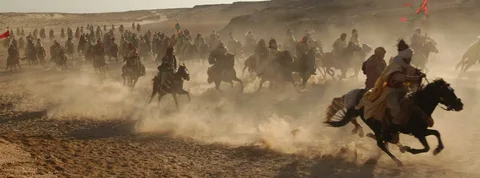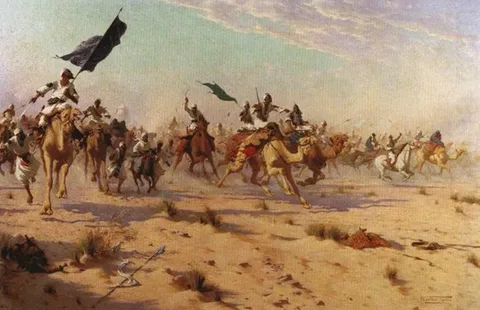The Battle of Badr Al-Kubrah (2 Hijri), fought on the 17th of Ramadan in the year 2 AH (corresponding to March 13, 624 CE), is one of the most significant and defining battles in early Islamic history. It marked the first major military confrontation between the nascent Muslim community led by the Prophet Muhammad (PBUH) and the Quraysh tribe of Mecca, who opposed the spread of Islam. Despite being heavily outnumbered and less equipped, the Muslims achieved a decisive victory, which had profound political, social, and religious consequences for the Muslim community and the Arabian Peninsula.
The Battle of Badr Al-Kubrah

After the Prophet Muhammad’s migration (Hijra) to Medina in 622 CE, tensions between the Muslims and the Quraysh of Mecca escalated. The Quraysh had persecuted the early Muslims, confiscated their properties, and sought to suppress Islam. The Muslims, now settled in Medina, began to challenge the Quraysh’s economic dominance by targeting their caravans, which were vital for Mecca’s wealth and trade.
In early 624 CE, the Muslims learned of a wealthy Quraysh caravan returning from the Levant, led by Abu Sufyan ibn Harb. The Prophet Muhammad planned to intercept this caravan as a form of economic retaliation and to weaken the Quraysh’s power. However, Abu Sufyan, aware of the Muslim plan, altered his route and sent urgent messages to Mecca for reinforcements. In response, the Quraysh assembled a large army of approximately 950 men, led by Amr ibn Hishām (known among Muslims as Abu Jahl), to protect the caravan and confront the Muslims.
The Battlefield and Forces
The battle took place near the wells of Badr, about 80 miles southwest of Medina. Control of the water wells was strategically crucial. The Muslims, numbering around 313 fighters including both Muhajirun (emigrants from Mecca) and Ansar (helpers from Medina), arrived first and secured the wells and advantageous positions.
The Quraysh army was almost three times larger, well-equipped, and confident in their numerical superiority. The disparity in numbers and resources made the Muslim victory all the more remarkable.
Read about: The battle of Al-Asherah (2 Hijri).
Course of the Battle
The battle began with traditional duels between champions from both sides. Notable Muslim warriors such as Ali ibn Abi Talib and Hamza ibn Abdul-Muttalib distinguished themselves in these initial combats. Following the duels, the full armies engaged in close combat.
Despite the Quraysh’s superior numbers and use of archers, the Muslims held their ground. The Prophet Muhammad’s leadership, combined with the high morale and unity of the Muslim fighters, played a crucial role. According to Islamic tradition, divine intervention also contributed, with reports of angels assisting the Muslims during the battle.
The Muslim forces managed to break the Quraysh lines, killing many of their key leaders, including Abu Jahl and Umayyah ibn Khalaf. The Quraysh suffered heavy losses, with around 70 killed and many captured, while the Muslims lost 14 martyrs.
Aftermath and Significance
The victory at Badr was a turning point for the early Muslim community. It boosted the morale of the Muslims and confirmed the Prophet Muhammad’s leadership and divine support. The triumph also enhanced the political and military standing of the Muslims in the Arabian Peninsula, encouraging tribes around Medina to ally with the Muslims.
The Quraysh, shocked by their defeat, lost much of their prestige and influence. The battle demonstrated that the Muslims, though fewer in number and less equipped, could successfully challenge the dominant powers through faith, strategy, and unity.
The Battle of Badr is mentioned explicitly in the Qur’an (notably in Surah Al-Anfal, 8:1-19) as a decisive moment of divine support for the believers. It is also called Yawm al-Furqan (The Day of the Criterion), symbolizing the clear distinction between truth and falsehood.
Lessons from the Battle of Badr
- Faith and Divine Support: The battle emphasizes the importance of faith in God’s help during adversity. The Muslims’ belief in divine assistance was a key factor in their victory.
- Leadership and Strategy: The Prophet Muhammad’s strategic planning, including securing the wells and choosing the battlefield, was instrumental.
- Unity and Perseverance: The cohesion between the Muhajirun and Ansar and their perseverance despite being outnumbered highlight the power of unity.
- Justice and Retribution: The battle was partly motivated by the desire for justice and to respond to the Quraysh’s oppression of Muslims.
Read more: The battle of Waddan (1 Hijri)
FAQs
Why was the Battle of Badr fought?
The battle was fought primarily because the Muslims aimed to intercept a wealthy Quraysh caravan as retribution for past persecutions and to weaken the Quraysh economically. The Quraysh responded by sending a large army to protect their caravan and confront the Muslims.
How many people fought in the Battle of Badr?
Approximately 313 Muslims fought against about 950 Quraysh warriors.
Who were the key leaders in the battle?
The Muslims were led by Prophet Muhammad (PBUH), while the Quraysh army was commanded by Amr ibn Hishām (Abu Jahl).
What was the outcome of the battle?
The Muslims won decisively, killing about 70 Quraysh fighters, including key leaders, and capturing many others. The Muslims lost 14 men.
What is the significance of the Battle of Badr in Islam?
It was the first major military victory for the Muslims, confirming the Prophet’s leadership, strengthening the Muslim community, and marking a turning point in the spread of Islam. It is also mentioned in the Qur’an as a sign of divine support.
Conclusion
The Battle of Badr Al-Kubrah stands as a monumental event in Islamic history, symbolizing the triumph of faith, courage, and strategic acumen over overwhelming odds. It was more than a military victory; it was a defining moment that solidified the position of Islam in Arabia and demonstrated the power of unity and divine support. The lessons from Badr continue to inspire Muslims worldwide, reminding them of the importance of steadfastness, leadership, and trust in God’s guidance in the face of challenges.

